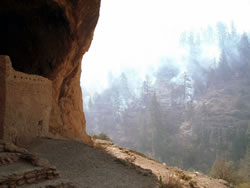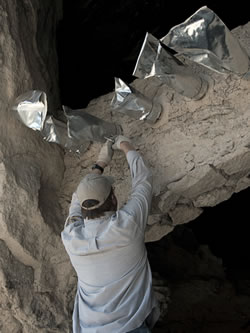National Cohesive Wildland Fire Management Strategy Success Story
Fuels Reduction Helps Protect Cliff Dwellings
Gila Cliff Dwellings National Monument, New Mexico
Cohesive Strategy - Fire-Adapted Human Communities
2011

Fire comes down Cliff Dweller Canyon.

NPS staff placing protective foil caps on prehistoric wood components of a cliff dwelling.
The 88,835 acre Miller Fire started on April 28, 2011 on the Gila National Forest, approximately six miles south of Gila Cliff Dwellings National Monument. The remoteness of the Miller Fire along with warm, windy conditions prevented firefighters from accessing the human-caused fire as it burned through steep, rugged terrain in the Gila Wilderness for several weeks. Early on, firefighters began planning and developing contingency lines around the Gila Cliff Dwellings and the small town of Gila Hotsprings.
In previous years, NPS fire management personnel had implemented a number of fuel reduction projects in preparation for a wildfire threatening the monument. The projects were designed to reduce hazardous fuel loadings in and around archaeological sites and the trail leading to the cliff dwellings. The preparation paid off during the Miller Fire.
As the fire approached the monument, fire management and park staff implemented previously-developed contingency measures to protect the cliff dwellings and other sites within the park, including 700-year-old wood features in the cliff dwellings.
While the fire burned through both units of the monument, hard work by staff and firefighters, including the installation of sprinkler systems in Cliff Dweller Canyon, protective wraps on exposed wood, and additional fuels removal around several sites, including the cliff dwellings and TJ Site, prevented any damage except the lower section of the trail going down to the dwellings, which suffered severe fire damage. Four older US Forest Service modular structures and the Middle Fork well house were destroyed when the fire burned through the administrative area on May 9th. A strong presence of structural fire trucks, sprinkler systems and firefighters prevented the fire from reaching any housing units, the visitor center, or the trailhead contact station and the shop areas.
Due to a near complete lack of moisture during the winter and spring causing extremely dry conditions, the fire continued to burn for several weeks. The monument was closed for public safety for about three weeks while the fire burned through the area. The Miller Fire was inactive as of July 27, 2011.
As of early August, heavy summer rains in the upper reaches of Cliff Dweller Canyon caused temporary closures of the trail down, where the trail runs in the creek bottom, washing it out or covering with several inches to several feet of water for as much as several days at a time. A National Park Service (NPS) trail crew completed assessment work and three to four weeks of rehabilitation on the down trail began in mid-August. Archaeology staff from the Santa Fe office of the NPS Intermountain Region also conducted post-burn assessments at both units.
Contact
Steve Riley, Superintendent
Email: Steve_Riley@nps.gov
Phone: (575) 536-9416